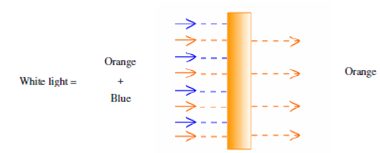Absorption Filters:
In low cost instruments catering to measurements within the visible range, colored glass filters are used to cut off undesirable wavelengths. A classic filter is a colored piece of glass that absorbs light of certain wavelength and permits that of the other to pass by. You know that white light is made up of seven various colors; the acronym is VIBGYOR for violet, indigo, blue, green, yellow, orange and red. These seven colors add up to give white light back. While white light falls on an object, an element of it is absorbed and rest is transmitted. These transmitted components add up to give the observed color of the object. The absorbed component and the observed color could again add up to give white light. These are thus called as complementary to each other. An object of a particular color looks of that color since this color is transmitted and its complementary color is absorbed.
In sequence to choose an appropriate filter for a measurement of absorbance of a solution, we need to have an understanding of complementary colors. The color of the filter should be the complementary to color of the solution to be measured. If a solution appears orange, this denotes that orange light is not being absorbed but that the complement to orange that is. blue is being absorbed. Thus, for measuring absorbance of an orange solution you would employ a blue filter. The use of such a filter is illustrated in Figure.

Figure: Use of an absorption filter for the measurement of absorbance